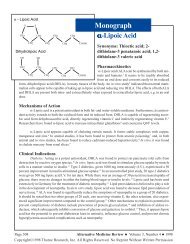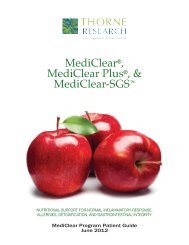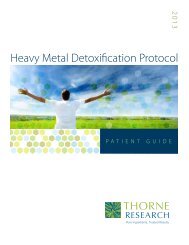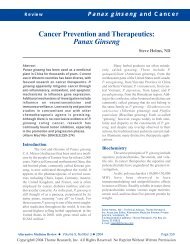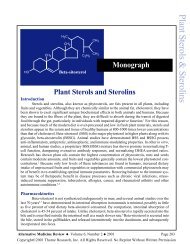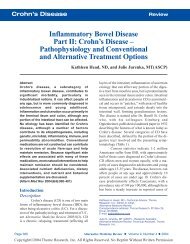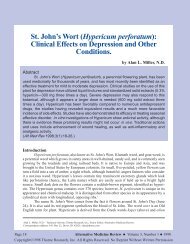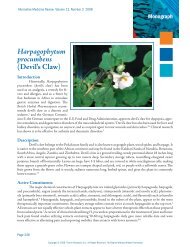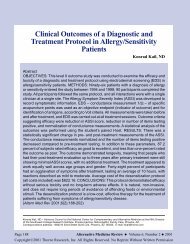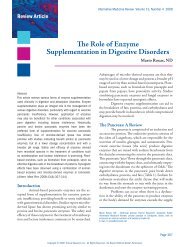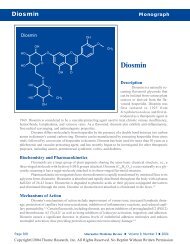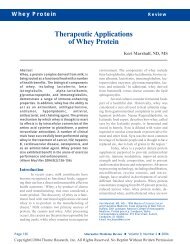You also want an ePaper? Increase the reach of your titles
YUMPU automatically turns print PDFs into web optimized ePapers that Google loves.
<strong>Wound</strong> <strong>Healing</strong> Review<br />
active constituents. Shukla et al showed a 0.2-percent<br />
asiaticoside solution applied topically twice<br />
daily for seven days to punch wounds in guinea<br />
pigs resulted in 56-percent increase in hydroxyproline,<br />
57-percent increase in tensile strength, increased<br />
collagen content, and better epithelialization<br />
compared to controls. Using the same punch<br />
wound model the researchers demonstrated an oral<br />
dose of 1 mg/kg for seven days produced a 28percent<br />
reduction in wound area and a significant<br />
increase of tensile strength and hydroxyproline<br />
content of the wound. 102<br />
Topical treatment with Aloe vera has been<br />
shown to improve healing in frostbite and electrical<br />
injury in animals. 103,104 In addition, Aloe vera<br />
has improved the healing of wounds in both normal<br />
and diabetic rats. 105,106 Topical application and<br />
oral administration of Aloe vera to rats with healing<br />
dermal wounds increased the collagen content<br />
of the granulation tissue as well as the degree<br />
of cross-linkage. Collagen increased 93 percent<br />
with topical treatment and 67 percent with oral<br />
treatment compared to controls. The increase was<br />
attributed to increased stimulation by Aloe vera<br />
of collagen synthesis or increased proliferation of<br />
fibroblast synthesis of collagen, or both. 107 In a<br />
similar study, the effects of oral and topical Aloe<br />
vera on full thickness dermal wounds in rats exhibited<br />
an increase in glycosaminoglycan components<br />
of the extracellular matrix and, in particular,<br />
hyaluronic acid and dermatan sulphate levels.<br />
107<br />
Aloe vera and Centella asiatica have been<br />
widely used for a host of curative purposes including<br />
facilitating wound repair. In spite of their<br />
wide use as folk remedies the biochemical basis<br />
for their action or influence on tissue repair is just<br />
beginning to be understood. Human clinical trials<br />
are needed to determine safety and benefits of<br />
perioperative oral administration of these botanicals.<br />
Topical application of both Aloe vera and<br />
Centella asiatica extracts to healing wounds or<br />
surgical scars appears to be safe and facilitates<br />
improved wound repair.<br />
Eclectic <strong>Wound</strong> Therapies<br />
Humans have always been faced with the<br />
dilemma of how to treat wounds. Many diverse<br />
and interesting approaches to wound management<br />
have been applied throughout medical history.<br />
Thirty years ago physicians believed pus in a<br />
wound was laudable and anxiously awaited its<br />
arrival; 108 surgeons today attempt every conceivable<br />
means to prevent its presence. Although scientific<br />
validation is absent, some wound-care<br />
therapies applied by eclectic physicians are still<br />
considered valuable and effective therapies today.<br />
Honey and sugar or sugar paste have been<br />
used to treat wounds for decades. Both are considered<br />
to be antimicrobial and have been associated<br />
with scarless healing in some cavity<br />
wounds. 109 Hyaluronic acid consists of disaccharide<br />
chains made from modifications of the<br />
monosaccharide glucose. One possible mechanism<br />
in scar prevention is that glucose in honey or derived<br />
from sugar may be converted into hyaluronic<br />
acid at the wound surface, forming an extracellular<br />
matrix that promotes wound healing. 109 Fetal<br />
wounds heal without scar formation and the extracellular<br />
matrix of fetal wounds is rich with hyaluronic<br />
acid and lacks excessive collagen. 109 The<br />
glucose in honey or derived from sugar may facilitate<br />
a balance between hyaluronic acid and<br />
collagen, similar to that found in fetal wounds.<br />
Preparations of fresh juice from Calendula<br />
officinalis preserved in alcohol, known as<br />
Calendula succus, are used topically to promote<br />
wound healing. Naturopathic doctors utilize Calendula<br />
succus to cleanse wounds after minor surgical<br />
procedures and throughout the healing process.<br />
External Calendula succus is listed in The<br />
Complete German Commission E Monographs for<br />
promoting wound healing. Topical application is<br />
thought to have anti-inflammatory and granulatory<br />
action. 110<br />
Knitbone and bruisewort are common<br />
names for Symphytum officinalis (comfrey) that<br />
give clues to its traditional uses. The active ingredient<br />
in comfrey is thought to be allantoin, which<br />
is reported to promote cell division and the growth<br />
of connective tissue, bone, and cartilage. Comfrey<br />
poultices are applied externally on intact skin<br />
Page 370 Alternative Medicine Review ◆ Volume 8, Number 4 ◆ 2003



